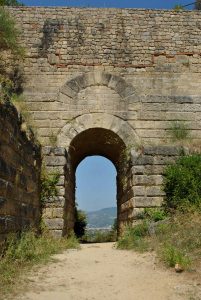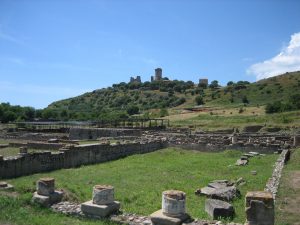When one thinks of Italy, images of art, food, fashion, and history come to mind. And when it comes to history, there is no shortage of iconic landmarks and architectural marvels that make Italy a must-visit destination for any history buff. Among these is Porta Rosa, Italy’s oldest arch, located in the city of Enna, Sicily.

Built-in the 4th century BCE, Porta Rosa is a well-preserved limestone arch that spans 3.6 meters wide and 5.8 meters high. It was part of the ancient Greek city of Henna, which later became a Roman colony. The arch was initially built as a gateway to the city, but its original function is still unclear. Some believe that it served as a ceremonial entrance to the city, while others suggest that it was used as a triumphal arch to commemorate a military victory.
Despite its age, Porta Rosa remains an impressive feat of engineering and architecture. The arch is made up of three massive blocks of limestone, each weighing around 20 tons. They were carefully carved and fitted together using a technique called “dry-stone walling,” which involves placing stones together without the use of mortar. The arch’s design is simple yet elegant, featuring two round-headed arches and a triangular pediment on top.
Visitors to Porta Rosa can marvel at the arch’s intricate details, such as the carved rosettes and the inscriptions on the architrave. The inscriptions mention the names of two architects, Gorgias and Memnon, who were likely involved in the arch’s construction. The arch’s age and historical significance make it a popular tourist attraction and a symbol of Enna’s rich cultural heritage.
Porta Rosa’s name, which means “pink gate,” is somewhat of a misnomer. While the arch is made of limestone, it has a pinkish hue that is said to be more prominent at sunset. The arch’s color and texture give it a warm, inviting glow that is especially striking against the backdrop of Enna’s rugged landscape.
Despite its beauty and historical significance, Porta Rosa remains relatively unknown outside of Italy. Many tourists flock to Rome, Florence, and Venice to see famous landmarks like the Colosseum, the Leaning Tower of Pisa, and St. Mark’s Basilica, but Porta Rosa remains a hidden gem waiting to be discovered.
Enna itself is a charming city that offers a glimpse into traditional Sicilian life. It is perched on a hilltop and boasts stunning views of the surrounding countryside. Visitors can stroll through the city’s narrow streets, sample local delicacies like cannoli and arancini, and soak up the laid-back atmosphere.
In addition to Porta Rosa, Enna has other historical and cultural attractions worth visiting. The city’s cathedral, built in the 14th century, is a stunning example of Sicilian Baroque architecture. The Lombard Castle, which dates back to the 10th century, offers panoramic views of the city and the countryside. And for those interested in Sicily’s ancient history, the archaeological museum has an impressive collection of artifacts from the Greek and Roman periods.

As for trivia, Porta Rosa has several interesting facts associated with it. One is that it was not discovered until the 20th century. The arch had been hidden for centuries behind a building that was constructed in front of it. It was only during restoration work in the 20th century that the arch was uncovered and recognized for its historical significance.
Another interesting fact is that Porta Rosa’s design has inspired architects and designers throughout the ages. The arch’s simple yet elegant lines can be seen in buildings and structures all over the world, from the Arc de Triomphe in Paris to the Brandenburg Gate in Berlin. In fact, the architect of the Arc de Triomphe, Jean-Francois Therese Chalgrin, is said to have studied Porta Rosa’s design closely before creating his own masterpiece.
Despite its relative obscurity, Porta Rosa has also made appearances in popular culture. The arch has been featured in several movies, including the 2010 film “Letters to Juliet” and the 2016 historical drama “Ben-Hur.” It has also inspired works of art, such as the painting “Porta Rosa at Enna” by Italian artist Renato Guttuso.
In conclusion, Porta Rosa is a fascinating piece of history and a testament to the ingenuity and craftsmanship of ancient architects and builders. Its age and historical significance make it a must-visit destination for anyone interested in Italy’s rich cultural heritage. And with Enna’s charming atmosphere and stunning views, a visit to Porta Rosa is sure to be a memorable experience.
